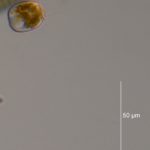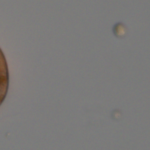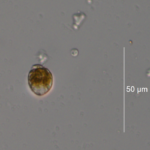Detected Species
-
HAB Species
- Diatoms
- Dinoflagellates
- Cyanobacteria
- Raphidophytes
- Haptophytes
-
Non-toxic Species
- Diatoms
- Dinoflagellates
Contact Us:
Mihaela D. Enache, Ph.D., Project Manager & Co-PI, Research Scientist I, Division of Science and Research, NJDEP (mihaela.enache@dep.nj.gov)
Ling Ren, Ph.D., PI, Research Assistant Professor, College of Science, George Mason University (lren2@gmu.edu)
Amphidinium carterae
Morphology
Cells about 11-24 µm long and 6-17 µm wide. Epicone (anterior portion of the cell) smaller than the hypocone (posterior portion). Cell dorso-ventrally flattened, oval in ventral view. Epicone asymmetric and pointed toward the left side. Hypocone elliptical with a slight convex right margin, a mostly straight left margin, and a smoothly rounded antapex. The cingulum is V-shaped and higher on the dorsal side.
Toxins and toxicity
The species can form HABs and is considered toxic. This species can produce a variety of polyketides that have hemolytic, cytotoxic, and fish mortality properties. In lab bioassays, the produced hemolytic compounds were found to be toxic to both mice and fish.
Ecology
The species is generally benthic and sediment-dwelling, but can temporarily become abundant throughout the shallow water column. The optimum conditions are at temperature of 18–23°C, and salinity of 15–35 ppt. It can encyst under high salinity and long daylight.
Distribution and Occurrence
A. carterae is a cosmopolitan species, and can be commonly found in intertidal, coastal, and estuarine waters, especially in association with sandy beaches and brown seaweeds. In this study, A. carterae was observed in ponds PGD-1 and OMWM-1 in January, February, and July.
References
Murray, S. A., G. S. Kohli, H. Farrell, Z. B. Spiers, A. R. Place, J. J. Dorantes-Aranda, and J. Ruszczyk. 2015. A fish kill associated with a bloom of Amphidinium carterae in a coastal lagoon in Sydney, Australia. Harmful Algae 49: 19–28. doi:10.1016/j.hal.2015.08.003
Lassus P.; N. Chomérat, P. Hess, E. Nézan. 2016. Toxic and Harmful Microalgae of the World Ocean / Micro-algues toxiques et nuisibles de l’ocean mondial. Denmark, International Society for the Study of Harmful Algae / Intergovernmental Oceanographic Commission of UNESCO. IOC Manuals and Guides, 68. (Bilingual English/French)
Yang, X., Z. Yan, J. Chen, D. Wang, and K. Li. 2023. Acute Toxicity of the Dinoflagellate Amphidinium carterae on Early Life Stages of Zebrafish (Danio rerio). Toxics 11: 370. doi:10.3390/toxics11040370



